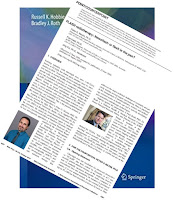Water transmits sound better than air, but its attenuation is an even stronger function of frequency. It also depends on the salt content. At 1000 Hz, sound attenuates in fresh water by about 4 × 10−4 dB km−1. The attenuation in sea water is about a factor of ten times higher (Lindsay and Beyer 1989). The low attenuation of sound in water (especially at low frequencies) allows aquatic animals to communicate over large distances (Denny 1993).
 |
| “Ocean Acidification and the Increasing Transparency of the Ocean to Low-Frequency Sound,” Oceanography, 22: 86–93, 2009. |
As the ocean becomes more acidic, low-frequency (~1–3 kHz and below) sound travels much farther due to changes in the amounts of pH-dependent species such as dissolved borate and carbonate ions, which absorb acoustic waves. The effect is quite large; a decline in pH of only 0.3 causes a 40% decrease in the intrinsic sound absorption properties of surface seawater. Because acoustic properties are measured on a logarithmic scale, and neglecting other losses, sound at frequencies important for marine mammals and for naval and industrial interests will travel some 70% farther with the ocean pH change expected from a doubling of CO2. This change will occur in surface ocean waters by mid century. The military and environmental consequences of these changes have yet to be fully evaluated. The physical basis for this effect is well known: if a sound wave encounters a charged molecule such as a borate ion that can be “squeezed” into a lower-volume state, a resonance can occur so that sound energy is lost, after which the molecule returns to its normal state. Ocean acousticians recognized this pH-sound linkage in the early 1970s, but the connection to global change and environmental science is in its infancy. Changes in pH in the deep sound channel will be large, and very-low-frequency sound originating there can travel far. In practice, it is the frequency range of ~ 300 Hz–10 kHz and the distance range of ~ 200–900 km that are of interest here.To get additional insight, let us examine the structure of the negatively charged borate ion. It consists a central boron atom surrounded by four hydroxyl (OH) groups in a tetrahedral structure: B(OH)4−. Also of interest is boric acid, which is uncharged and has the boron atom attached to three OH groups in a planar structure: B(OH)3. In water, the two are in equilibrium
The equilibrium depends on pH and pressure. Brewer and Hester write
Boron exists in seawater in two forms—the B(OH)4− ion and the un-ionized form B(OH)3; their ratio is set by the pH of bulk seawater, and as seawater becomes more acidic, the fraction of the ionized B(OH)4− form decreases. Plainly, the B(OH)4− species is a bigger molecule than B(OH)3 and, because of its charge, also carries with it associated water molecules as a loose assemblage. This weakly associated complex can be temporarily compressed into a lower-volume form by the passage of a sound wave; there is just enough energy in a sound wave to do it. This compression takes work and thus robs the sound wave of some of its energy. Once the wave front has passed by, the B(OH)4− molecules return to their original volumes. Thus, in a more acidic ocean with fewer of the larger borate ions to absorb sound energy, sound waves will travel farther.As sound waves travel farther, the oceans could become noisier. This behavior has even led one blogger to ask “could ocean acidification deafen dolphins?”
Researchers at the Woods Hole Oceanographic Institution are skeptical of a dramatic change in sound wave propagation. In an article asking “Will More Acidic Oceans be Noisier?” science reporter Cherie Winner describes modeling studies by Woods Hole scientists such as Tim Duda. Winner explains
Results of the three models varied slightly in their details, but all told the same tale: The maximum increase in noise level due to more acidic seawater was just 2 decibels by the year 2100—a barely perceptible change compared to noise from natural events such as passing storms and big waves.
Duda said the main factor controlling how far sound travels in the seas will be the same in 100 years as it is today: geometry. Most sound waves will hit the ocean bottom and be absorbed by sediments long before they could reach whales thousands of kilometers away.
The three teams published their results in three papers in the September 2010 issue of the Journal of the Acoustical Society of America.
“We did these studies because of the misinformation going around,” said Duda. “Some papers implied, ‘Oh my gosh, the sound absorption will be cut in half, therefore the sound energy will double, and the ocean will be really noisy.’ Well, no, it doesn’t work that way.”































